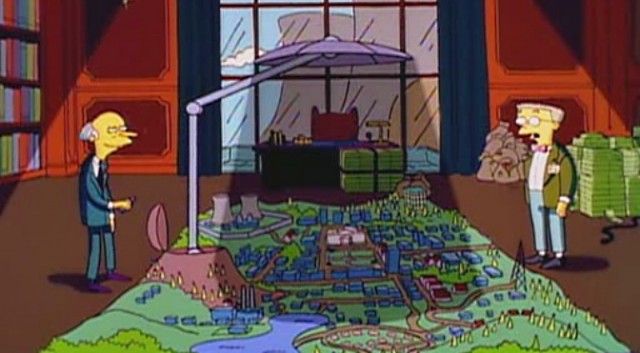Could Solar Panels placed between Earth and Sun reduce Global Heating?

Image taken from an episode of the Simpsons where Mr Burns' scheme to profit from increased electricity consumption sees him plunging Springfield into perpetual darkness.
I am writing this for a friend who shared with me an article on the possibility of using a ginormous array of solar panels parked between the Earth and the sun, in order to offset global heating.
Sending solar panels to space
Summarising the article published in medium.com:
- An array of solar panel probes could be positioned between the Earth and sun to block solar radiation. Placing them at the L1 Lagrange point (where the gravitational pull of the sun and Earth cancel out) allows them to remain almost stationary without use of engines.
- The L1 Lagrange point is an unstable equilibrium between the Earth and the sun. We would need to position the spacecraft slightly in front of L1, towards the sun, to balance pressure from solar radiation. Perturbing drift (caused by solar wind) could be managed by using the solar panels as solar sails, tilting the panels as required to navigate to a desired position.
- To reduce temperature rise on Earth by approximately 1.5°C would require over 1 million square kilometres of radiation blocking panels, equivalent to one trillion 1 metre by 1 metre square panels.
- The article suggests launching these probes over the span of 20 years, utilising lightweight materials and packing analogous to a larger version of cubesat, allowing 20 000 probes to be launched in a single reusable rocket. Ambitious, but plausible given investment into the technology.
One possible cost saving measure and alternative to 100 tonne payload rockets, could involve utilising space lifts or swings to launch the probes to Low Earth Orbit (LEO). Recent media hype over a Japanese team working on space lift tethers between satellites quoted 2050 as a possible arrival date for ground to LEO space lifts. Such predictions aren’t realistically very informative, it may take much longer for the technology to mature.
But in terms of getting the solar panels to L1 and keeping them there, it seems at least plausible economocially, even without space lifts. However the article stops short of exploring the actual impacts of reducing the incoming solar radiation by 1%. What would this actually mean for planet Earth?
Impacts of 1% solar radiation reduction
The idea of blocking radiation by releasing chemicals high up in the atmosphere has already been well explored and modelled. A 2017 article in the conversation focuses on the risks from chemical blocking, risks which mostly wouldn’t be applicable for solar panel blocker. Instead, the main risks we face are the result of the disturbances to Earth’s complicated, dynamic weather and climate systems.
In 2008, modelling carried out by a research team at Bristol University compared a model of Earth with CO2 induced temperature rise of 6.0°C, to a model with the same levels of CO2, but warming cancelled out by a use of radiation blocking solar panels.
The modelling showed that solar radiation management might reduce the risks of climate change to most of the world, but the distribution of cooling is non-uniform. Equatorial regions were 1.5°C below pre-industrial temperatures, wihlst higher latitudes were more than 1.5°C warmer. These temperature changes represent very significant changes to Earth’s climate, and would have extreme effects on our weather systems, however the researchers say that the overall impact of this new temperature distribution would be much less harmful to life than the impact of 6.0°C of temperature rise.
Conclusion: Can it work?

Breaching Humpback 2 by is licensed under CC BY-NC-SA 2.0
The main unsolved problem of the sun blocker is ocean acidification. The effects on plankton and all sea life would be catastrophic, and just as severe in the shaded scenario as unshaded, since the levels of CO2 are identical. So whilst the use of solar radiation blocking panels could act as a last resort measure to reduce the impacts of climate change, it is not a safe replacement for reduction of CO2 emissions which must drop to net zero within the next ten to twenty years to avoid greater than 2.0°C temperature rise.
This work is licensed under a Creative Commons Attribution-ShareAlike 4.0 International License.




